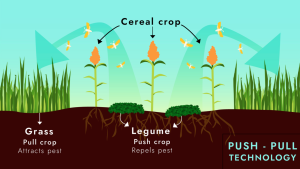Hungry caterpillars threaten Kenya’s crops. Can plants provide a natural pest control solution?
Kenyan farmers face a tiny but destructive threat: the fall armyworm, or Spodoptera frugiperda. Despite its small size, this striped greyish-green caterpillar wreaks havoc on cereal production. Kenya’s three staple crops—maize, sorghum and rice—also happen to be its favourite food.
Climate change is resulting in increased fall armyworm infestations, which can have drastic impacts and may affect food security.
A plant-based solution for a plant-based problem
Luckily, there is a surprisingly simple, sustainable and affordable solution. With push-pull technologies (PPT), the cereal crop is planted alongside a legume which repels the pest (the “push” crop), while a grass grown at the edge of the field attracts the pest. This “pull crop” provides a conducive environment for the pest to lay eggs but not for larvae to develop.
Not only does this biological approach to pest control replace harmful chemicals, it also improves soil fertility thanks to the nitrogen-fixing qualities of the legumes. The legumes in turn provide an additional food source for humans, while the grasses can be used as livestock feed.

Does it work?
To respond to increasing pest and disease outbreaks, the IFAD-supported KCEP-CRAL project promotes innovative and sustainable agricultural practices to help farmers combat the effects of climate change while improving cereal and pulse production.
In partnership with the Kenya Agricultural and Livestock Research Organization (KALRO), KCEP-CRAL tested the efficacy of PPT to control fall armyworm in different agro-ecological contexts.
They found that the indigenous and drought-tolerant Lablab legume (Lablab purpureus) is an effective push crop, reducing the fall armyworm population in maize by 40 per cent. Lablab can be used in place of more expensive and harder to find crops.
Getting this solution into farmers’ hands
Throughout 2019, KCEP-CRAL conducted on-farm PPT demonstrations to promote the technology among small-scale farmers. By 2022, 600 farmers in KCEP-CRAL areas had adopted the practice, showing that smallholder producers will invest in new technologies if they are easy to apply and provide a cheaper, beneficial alternative.
As the global community searches for sustainable solutions to climate change and its impacts, PPT is a proven, natural and effective solution to control pests, while improving agricultural productivity and food security. Not only this, PPT promotes biodiversity by enhancing soil fertility, using indigenous plants and replacing harmful chemicals.
This simple solution has the potential to transform pest control and, in turn, protect food security in sub-Saharan Africa.